Stay updated with the latest sports news across Cricket, Football, Chess, and more. Catch all the action with real-time live cricket score updates and in-depth coverage of ongoing matches.
South Africa’s role clarity, multiple heroes and simple plans trumped India’s muddled thinking and musical-chairs approach
“Even in an organisation, everyone wants to know where they stand. Everyone wants to know what is expected of them," says South Africa captain Temba Bavuma.
 South Africa players celebrates with wining trophy during the Day 5 of the 2nd Test match between India and South Africa at ACA Stadium, Guwahati, India, on November 26, 2025. (CREIMAS for BCCI)
South Africa players celebrates with wining trophy during the Day 5 of the 2nd Test match between India and South Africa at ACA Stadium, Guwahati, India, on November 26, 2025. (CREIMAS for BCCI)“Every Test match, they bat first, they score 500, they declare when it’s dark, they get three wickets when it’s dark and when day three starts, you’re under pressure. It was like copy and paste in every Test match.”
In the final chapters of his international career, Faf du Plessis went through the ultimate test of body and mind on a depressing 2019 India tour that blanked the Proteas 0-3. The crisis deepened in his position as captain. He would lead once more at home before stepping down in February 2020.
Du Plessis’s assessment of the Indian conditions and the home team’s ruthless dominance over the various phases of play would remain firmly with Temba Bavuma, his vice-captain on that dreaded India trip. Taking over as captain in 2022 and equipped with an expanding, world-beating arsenal of match-winners, Bavuma’s boys shook the foundations of the Indian Test game in Guwahati on Wednesday. The 2-0 clean sweep marked their first series win in India in the 21st century.
Even if one were to discount the ragged Kolkata Test, the 408-run margin of their latest triumph underlined the growing possibilities of this side, whipping up an earnest throwback to Graeme Smith’s invincibles, who possessed the coveted ICC Test championship mace for 21 months between 2012 and 2014.
The cruel takeaway for Gautam Gambhir’s men from this humbling is that every missing piece of their convoluted Test puzzle is discernibly placed in the altars of the South African dressing room. They aren’t some mind-bending concepts, but simple building blocks of clarity and a sense of belonging, unlike the musical chairs of playing positions India have set themselves on.
 South Africa’s players celebrate after South Africa wins the test series against India in Guwahati, India, Saturday, Nov. 22, 2025. (AP Photo/Anupam Nath)
South Africa’s players celebrate after South Africa wins the test series against India in Guwahati, India, Saturday, Nov. 22, 2025. (AP Photo/Anupam Nath)
“Even in an organisation, everyone wants to know where they stand. Everyone wants to know what is expected of them. As a captain, sometimes it’s very hard to take the ball out of the bowler’s hands. You see it with the batting as well. Everyone is contributing. We don’t have the guys who go on and score big, 150s and all, but we’ll have four or five different guys who are going on to score 60s and 70s,” a proud Bavuma would tell after successfully flipping their Indian scripts.
The collective simplicity has propelled Bavuma’s rapid success as captain. Twelve matches in, the World Test Championship-winning captain has yet to bear a defeat in his ledger, making it the most successful start for a captain ever in Test match history.
Simon Harmer’s second-innings six-fer, Marco Jansen’s first-innings six-fer and seven-sixer-loaded 93, the promoted No.3 Tristan Stubbs’ 49 and 94, Aiden Markram’s world record nine catches, Senuran Muthusamy’s unforeseen rearguard ton — these many architects of the Guwahati mauling also carried out a terrific recce of the Northeast conditions to beat the mediocre Indian outfit.
Short-ball barrage
It took Jansen’s short-ball barrage, in only his third Test in Asia, to elucidate the most effective bowling lengths on a pitch where Jasprit Bumrah and Mohammed Siraj sent down 62 overs for four wickets on days one and two.
It had to be the 14-match-old Stubbs who would forewarn the pitfalls of being over-defensive on days four and five and the need for innovative counteragents like the sweep and the reverse-sweep. “If you looked to defend, you might be a sitting duck. The reverse sweep was more of a defensive shot to get off strike,” he said on Tuesday, before the last stretch of India’s mortifying unravelling began.
It would also be the 36-year-old Harmer, who has self-admittedly only had a “snapshot of Test cricket” with 14 matches in 10 years, but importantly a profile of 1000 First-Class wickets, and his teeming success with altering speeds that leaves a crucial lesson for his Indian counterparts.
“With the red soil pitch being bouncier, we felt that the slower pace would be better. And I don’t know if they (India) got caught up in what happened in the first Test, because I think the comparison (in Kolkata) was that our speeds were a little bit quicker than theirs, that they felt that maybe they needed to be quicker (here),” Harmer said after his player-of-the-series performance with 17 scalps.
“Extremely proud,” wrote du Plessis in his congratulatory message for the blooming Proteas on social media.
South Africa’s reversal of the Indian mantra, decoded by du Plessis in 2019, will stand as the benchmark that Gambhir’s unit will strive to regain.

































